The NVIDIA GeForce GTX 650 Ti Review, Feat. Gigabyte, Zotac, & EVGA
by Ryan Smith on October 9, 2012 9:00 AM ESTCompute Performance
As always our final set of real-world benchmarks is composed of a look at compute performance. As we have seen with GTX 680 other Kepler cards, Kepler appears to be significantly less balanced between rendering and compute performance than GF110 or GF114/GF116 were, and as a result compute performance suffers. On the other hand, relative to the GTX 660 the GTX 650 Ti sacrifices a smaller portion of its compute performance than its ROP/L2/memory performance, so this may bode better for computer performance.
Our first compute benchmark comes from Civilization V, which uses DirectCompute to decompress textures on the fly. Civ V includes a sub-benchmark that exclusively tests the speed of their texture decompression algorithm by repeatedly decompressing the textures required for one of the game’s leader scenes. Note that this is a DX11 DirectCompute benchmark.
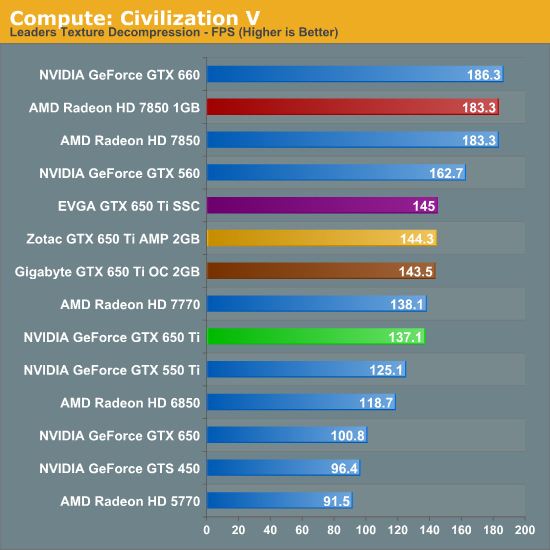
There really isn’t a lot to say here. The GTX 650 Ti is only slightly ahead of the GTX 550 Ti, never mind the GTX 560. Worse, it’s tied with the 7770 and well behind the 7850. Given the nature of the test, with cards on memory busses this small I believe we’ve run into a proxy test for memory bandwidth rather than compute throughput. Which just goes to show that all of that compute throughput is meaningless without the memory bandwidth and cache to feed the best.
Our next benchmark is SmallLuxGPU, the GPU ray tracing branch of the open source LuxRender renderer. We’re now using a development build from the version 2.0 branch, and we’ve moved on to a more complex scene that hopefully will provide a greater challenge to our GPUs.
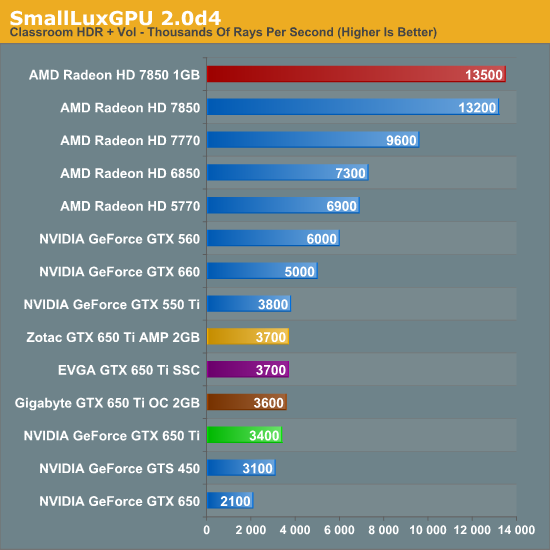
Not surprisingly, the GTX 650 Ti loses to just about everything. SmallLuxGPU’s OpenCL renderer just doesn’t mesh well with Kepler and NVIDIA’s drivers. The resulting lead for the 7850 is nothing short of massive.
For our next benchmark we’re looking at AESEncryptDecrypt, an OpenCL AES encryption routine that AES encrypts/decrypts an 8K x 8K pixel square image file. The results of this benchmark are the average time to encrypt the image over a number of iterations of the AES cypher.
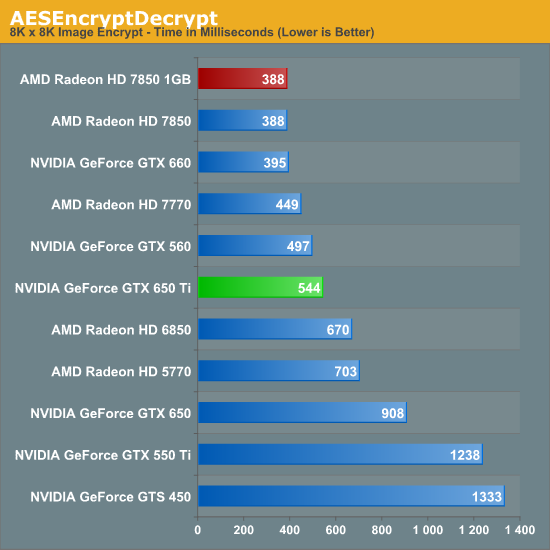
Unlike our previous OpenCL benchmark the GTX 650 Ti’s showing isn’t nearly as bad, but neither is it great. Both the GTX 560 and the 7770 are in the lead, but at least the improvement over the GTX 550 Ti is nothing short of amazing. At times NVIDIA’s problem isn’t where GTX 650 Ti is compared to last-generation cards, but rather it is compared to AMD’s strong Radeon HD 7000 series lineup.
Our fourth benchmark is once again looking at compute shader performance, this time through the Fluid simulation sample in the DirectX SDK. This program simulates the motion and interactions of a 16k particle fluid using a compute shader, with a choice of several different algorithms. In this case we’re using an (O)n^2 nearest neighbor method that is optimized by using shared memory to cache data.
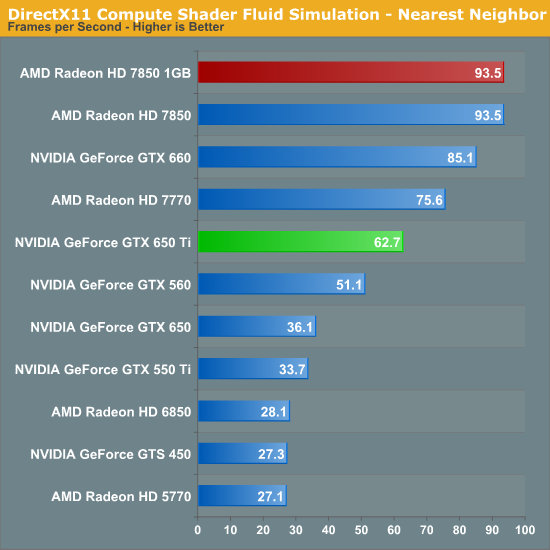
Once more the GTX 650 Ti is in trouble. It can beat the GeForce 500 series, but even the 7770 is faster.
Finally, we’ll take a look at one last benchmark to our compute run with the benchmarkable version of the Folding@Home client. Folding@Home and similar initiatives are still one of the most popular consumer compute workloads, so it’s something NVIDIA wants their GPUs to do well at.
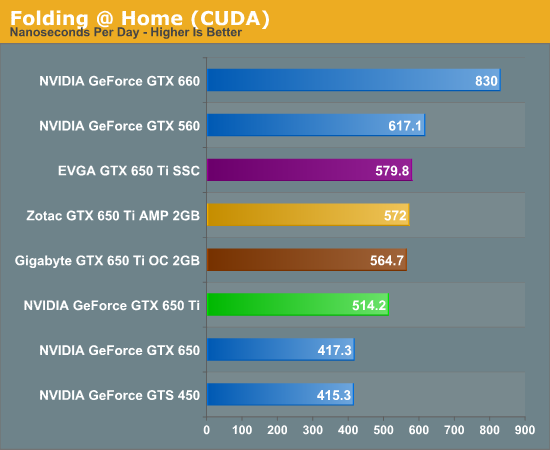
Here’s another case where memory bandwidth and L2 cache appear to be a problem. The GTX 650 Ti is much farther behind the GTX 660 than we would have expected, and even the GTX 560 can take a lead here. On the other hand memory bandwidth bottlenecking isn’t so bad that EVGA’s GTX 650 Ti can’t still take the lead over the other factory overclocked cards.










91 Comments
View All Comments
Galidou - Saturday, October 13, 2012 - link
I won't be back on that thread anymore but just wait for some more stupidly stubborn reply of Cerise, that guy is just a show by himself. His level of global consiousness is below anything I have yet to see in the whole world.Sure he has some knowledge, can't deny it, it's just used in a way that seems like all that potential is totally WASTED, thrown to the garbage, buried in vomit and so on.....
Funniest shit ever.... LOL funniest comments ever..... Can't beleive it.....
Speelteveel - Wednesday, March 13, 2013 - link
Please provide these benchmarks where the oc'd 650ti "flies" past the 7850.Its not a 50 buck price diff, its 20.
Also, in these benches above, the 7850 is not overclocked.
So basically, you advocate to pay $20 less for a card that you have to overclock to get similiar performance, when the $20 more expensive card when oc'd goes into another spectrum of perfomrnace that the 650ti can't even fathom. Oc'd 7850s break even with 7870 benchmarks at 1080p.
I'm not going to link you the benchmarks you can peruse google y yourself.
the 650ti can't compare to the 7850 at all. I'm no fanboy, I just found your post dissing fanboys while blatantly being blindly biased very amusing.
vbmluis - Friday, October 12, 2012 - link
Yeah, I remember one, ATi HD 2900, heavy, big, noisy, power hungry, pricey and low performance.Jamahl - Tuesday, October 9, 2012 - link
It's not bad. It's just slow, expensive and late.Samus - Tuesday, October 9, 2012 - link
lol, that defines bad, man!But I'd argue...the only thing really wrong with this card is there isn't any good reason or it to be dual slot. with that power envelope, nVidia really could have rocked the house if this thing were a single slot, maybe even half height card (especially the 650 non-TI) because it's make a very powerful USFF/ITX PC GPU.
Aside form my dream of this card being single slot, it isn't a terrible card. The 650 Ti is mostly on par with the old 560 (which still costs more) while using less power and being half the length. Pretty much a no-brainer which one to buy there. But neither card is really worth $150-$180 when you consider you get substantially more (25-40%) performance from the 660 for just 20% more monies.
Blazorthon - Tuesday, October 9, 2012 - link
Don't forget, the 7850 comes with games and so does the 7770. Coming with a game is necessary just to compete right now. The 7770 also has some highly factory overclocked models that can inch out the 650 Ti while still being cheaper. The 650 Ti would do better at $10 or $20 lower and a MIR is a great way to accomplish that since a lot of people forget to do them anyway, but buy the card because of the after MIR price.TheJian - Tuesday, October 9, 2012 - link
Love defending AMD everywhere you go don't you :)Until you OC the 650 (or buy one already done, you act like they don't sell them on both sides OC'd) making your point moot. No phsyx either.
http://www.geforce.com/games-applications/physx
Even batman AA supports it. I don't think the 7770 comes with a current AAA title such as Assassins Creed 3 (doesn't get any more current than a game NOT even out yet). That will make a nice xmas gift to themselves for anyone buying one. Metacritic has a date of Nov20th, which is plenty of time for them to even be late a few weeks an still play over the holidays.
I'd be more than happy to have another round like we did at Toms if you'd like :) You start claiming MSAA crap again and we'll have a go...LOL
Please refrain from saying AMD is financially competitive with Intel here like over at Tom's, I don't want to waste my time burying that one again...ROFL.
abianand - Wednesday, October 10, 2012 - link
I have a slight preference from AMD cards (I don't why and I don't like having a slight preference between two equally and fairly-competing brands).Having said that....
7850 is definitely faster, but look at the power consumption of the 650Ti. Even an overclocked 650Ti draws power that just equals a normal non-overclocked 7850. So, I wouldn't call the 650Ti a bad product at all, especially when it manages to touch 30fps in almost all settings in almost all games.
Samus - Wednesday, October 10, 2012 - link
I have a preference for nVidia drivers, but these days both companies make solid chips. The real problem for AMD is all the games I play (mostly EA games) are optimized for nVidia architecture...like how Source was optimized for ATI architecture.Just how it goes.
Death666Angel - Wednesday, October 10, 2012 - link
"Until you OC the 650 (or buy one already done, you act like they don't sell them on both sides OC'd) making your point moot."Wait, so you can't OC AMD cards? Oh that's right, you can. So that is meaningless, as any OC gains from Nvidia cards will be (likely) negated by OCing the respective AMD cards.